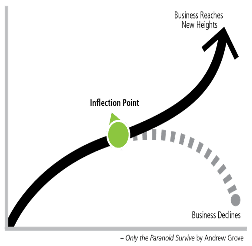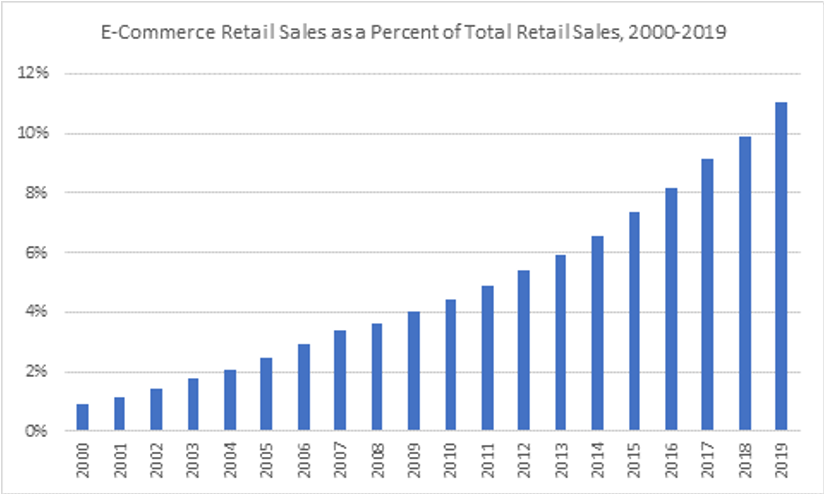The Big Jump: Pandemics And The Connected Economy’s Bigger, Faster Future

To understand when and how consumer demand will return and the impact it will have on federal and state efforts to reopen the economy, we need consistently refreshed data from a large national sample to get out of the quarantine “information bubbles” and see the big picture.
For the last eight weeks, I have used data from our every-10-day study of more than 12,000 U.S. consumers and Main Street SMBs to explain the impact of the abrupt shift to digital that was forced on consumers and businesses when the economy shut down in mid-March. We have observed the rapid acceleration of online behaviors that were nascent when consumers had a choice of how and where to shop, how and where to eat, and how and where to travel and work.
We have also begun to document the reopening roadmap for people and Main Street SMBs — a recovery that will be consumer-driven even though it is technically federal- and state government-led.
But to understand how that thinking and those behaviors will influence the direction of the connected economy over the next decade, we need to start with a little math.
Inflection Points And Jump Discontinuities
Take this graph of a two-dimensional function. The line is chugging along. Then, all of a sudden, the curvature changes. Maybe things speed up or slow down. That’s an inflection point.

Image source: “Only the Paranoid Survive” by Andrew Grove
Entrepreneurs live for inflection points — well, mostly the ones that go up and to the right. It’s the point where sleeping under their desks and eating ramen noodles has paid off, and their growth accelerates. Their businesses ignite. Fortunes are made.
Andy Grove popularized inflection points in business in his famous book, “Only the Paranoid Survive.”
For platform businesses, these “ignition points,” which were popularized by “Matchmakers” authors David Evans and Dick Schmalensee, happen when the platform has solved the chicken-and-egg problem and gotten enough critical mass for sustained, profitable growth and scale.
And what’s true for startups is true for markets overall.
Demand grows slowly at first, and then more and more people see the benefit of buying a new product or joining a new service. The market takes off and pulls along the firms that introduce those new products or services to consumers or businesses.
Something very different can happen, though — something that math geeks (and I am not one of them) call a jump discontinuity.
A jump discontinuity is where the function breaks sharply and, well, jumps. If you were walking along the path of the function, the discontinuity is like having to climb up a ladder, or jump down a cliff, to a new path.
In business, a jump point is when something abruptly happens. That could be good, taking things to new heights. Or it could be bad, falling in the abyss. Sometimes it can be both, depending on the business.
The fact of the matter is that hardly anything ever happens abruptly in business and technology. If you look at most major innovations, for example, they diffuse slowly and seem to take longer than anyone expected.
Take the internet. Back in the mid-1990s, people talked about “internet time” and how rapidly changes would take place.
Take a look at eCommerce. It has grown slowly and steadily based on the Census data. The average annual growth rate has been flat at 15.3 percent since 2010. The convex shape in the last decade simply reflects compounding.
A lot came together at the end of the 2010s, which made me believe that we were actually at an inflection point for the connected economy. It became apparent that the combination of technology, software, artificial intelligence (AI), connected devices, payments technology, data and the cloud would move us away from the apps-based economy that defined the decade of the 2010s and toward one that would give shape to new connected ecosystems and new ways for consumers and business to interact within them.

Source: U.S. Census Data
And that the growth of the connected economy would accelerate over those 10 years.
That was the premise of my January piece on the future, and how the next decade would evolve and who would shape it.
January, when I wrote that piece, now seems like a lifetime ago.
In fact, so does March.
COVID-19 Breaks The Curve
Unless you’ve been camping out in Antarctica, embracing your New Year’s resolution to disconnect, you are all too aware that we are in the midst of what could be the most important discontinuity in our lifetimes.
At one point, many thought this discontinuity would last a few weeks — not so much a jump that would be visible to observers looking back from the future. It was expected to be a short, funky period, a little bump in the road — and we would return to normal before we knew it.
The infamous “V-shaped recovery.”
But now the duration, depth and contours of the disruption, while uncertain, will clearly be longer, deeper and more sweeping than many imagined a few months — and perhaps even a few weeks — ago.
What is clear is that the crisis has resulted in a jump discontinuity that will have dramatic consequences for the evolution of the connected economy over the next decade and beyond.
The pandemic will eventually subside.
People will be able to get medicine for an infection. There’s a good chance that within the next 18 months, we’ll have a vaccine that will protect many. People will want to embrace physical interactions again. They may even have a pent-up demand to go dancing and crowd into concerts and stadiums.
But looking back, we are likely to see 2020 as the year in which the connected economy made a quantum leap to a higher level of activity, faster growth and more rapid innovation.
Some businesses will find their way back onto that path (or climb up those steps to get back onto it). Many will get lost and find that the path they were walking is now a road to nowhere.
Was The Connected Economy At An Inflection Point At The End Of 2019?
Despite the decade of long, steady growth, it was apparent — though perhaps not certain — that the connected economy was at an inflection point at the end of 2019. It looked like the move from physical to online was accelerating, or at least poised to do so soon.
You could see and feel the momentum, driven by innovators with new solutions and platforms, buoyed by consumers with an insatiable appetite for integrating connected devices and new tech into their day-to-day routines.
People were already gradually replacing their physical activities with their online counterparts. They were learning the convenience of shopping on Amazon and other eCommerce platforms, and getting things delivered to their door. No fuss, no muss.
Physical retail was in serious decline, with massive store and mall closures, and department stores and others on the precipice of bankruptcy. As more traffic disappeared and more stores shuttered, even more retail would happen online — the effect became the cause of its decline.
Car manufacturers were struggling, and rental car companies were in bad shape. Personal travel had moved over the course of the 2010s to ridesharing services. Sure, they were yet to turn a profit, but it was clear they would prosper — and that the automobile industry would have to reinvent itself, and that rental car companies were not long for this world at a significant scale.
It has taken a long time for people to get into ordering their groceries online. But innovations in the gig economy and logistics-enabled platforms like Instacart, as well as the grocery stores themselves, made it increasingly easy for people to order online and get what they wanted quickly delivered. And, of course, Amazon pushed delivery of center-of-the-aisle consumer products to Amazon Pantry in 2014, and later everything through Whole Foods.
People had so many more choices for doing high-quality video calls from their mobile devices or desktops than ever before. Many of us found that it was a lot easier and less disruptive to have meetings over the phone. Why jump on a plane and have to host a visitor when you could use BlueJeans, Zoom or Skype? Too small to really dent the air travel business, perhaps, but the direction was clear.
The list goes on across the 10 pillars of the connected economy: how we eat, shop, pay, live, travel, bank, work, communicate, have fun and stay well.
In all of these cases, consumers were substituting online solutions that had more capability and less friction than physical-world options. And as they did so, more people followed. Physical solution providers started withering, making them less appealing and pushing more people online.
Meanwhile, the next generation of advanced cellular technologies was about to be deployed. A decade earlier, starting around 2011, the U.S. carriers started installing 4G networks. By 2014, that resulted in a massive jolt to the smartphone ecosystem, and an inflection point in app adoption and use. In early 2020, carriers were starting to deploy 5G technology, which would blanket every nook and cranny of the physical world with extraordinarily fast and wide data pipes.
Those developments set the stage, as of Jan. 1, 2020, for an important inflection point. That was the basis of my thesis — then.
The March 2020 Jump
Then COVID-19 hit.
The pandemic has pulled people from their physical activities to virtual equivalents across all of the 10 pillars of the connected economy.
In some cases, people just didn’t have physical solutions to turn to. In other cases, the physical solutions, like going to the grocery store, weren’t as good as they used to be, with the risk of infection just one of the problems. And so people substituted online solutions for degraded physical alternatives.
A few weeks of this would perhaps be a blip. The future observer looking back who didn’t remember the pandemic might not even notice it in a timeline of the adoption of online methods or the decline of physical ones.
But we can be pretty sure this is a quantum leap.
Take the U.S. (although similar things are happening almost everywhere). Tens, if not hundreds, of millions of people are trying online solutions that weren’t on their radar a few months ago, or they are using online solutions much more.
PYMNTS’ surveys of consumers (12,000 so far) during the pandemic have documented the shift. Based on population projections in on our surveys, 12 million more people used online grocery ordering between March 6 and April 27 than in January of 2020.
Think of that — 12 million more adopters of a relatively new digital behavior in less than two months.
When people feel safer shopping in the physical grocery store — and two-thirds of the consumers we study say they fear getting sick while shopping for groceries in the store — some of these people will revert to their old ways.
Many will continue to use online solutions more.
The COVID-19 Jump
To see how important the COVID-19 jump really is, consider the diffusion of some older innovations.
People were pretty happy riding horses and being pulled along in horse-drawn carts. It took a long time to persuade people to get cars or for governments to build roads. Now just think what would have happened if a pandemic wiped out much of the horse population.
Or the adoption of electricity. Folks were pretty happy with whale oil for their lamps — but what if the whales died?
In both cases, some people might have gone back to horses and whales. Many would have stuck with the new ways of doing things — particularly as more of their friends, family and neighbors did so — leaving oil lamps and horses behind.
The same will be true for the connected economy.
Most every adoption curve — across online platforms and across the 10 pillars — will have a break in early 2020, with a jump upward, from which growth will happen.
As a result, high degrees of penetration will take place earlier across all parts of the connected economy.
Across every single one of those 10 pillars.
Who Benefits From The COVID-19 Jump?
The big, immediate beneficiaries of the COVID-19 jump are online platforms that had made significant innovations, but whose success wasn’t guaranteed. Platforms like Instacart were still losing money even though they had gotten large. And some others, like Grubhub, were bleeding cash. A deeper dive than I can do here would probably show many more platforms, apps and online businesses in similar situations.
The COVID-19 jump provided a rapid surge in customers and use. For some platforms, that means achieving critical mass for self-sustaining growth is possible. For others, it means crossing the profitability line — as in the case of Instacart, which finally eked out a profit. And for still others, like Zoom, it has meant going from being yet another successful platform to being a superstar.
Meanwhile, the large, established platforms have in one fell swoop pulled in millions of dedicated users, and have become entrenched as the go-to places for the connected economy. Take Amazon, for example. Its eCommerce business has benefited in three ways.
First, more people are using Amazon for online ordering, leading it to hire hundreds of thousands of additional workers for warehousing and delivery.
Second, more retailers are signing up for Amazon Marketplace as their fear of going under overtakes their suspicion of Amazon. And many of the physical retail alternatives to Amazon won’t see the other side of the pandemic, as bankruptcies and closures rapidly pile up.
A similar story with a twist is playing out at Facebook and Google.
Usage is surging as people under lockdown spend more time on connected devices for communication and entertainment. The companies’ ad revenues have taken a hit as the economy sags. They’ll survive that, but many of their ad-supported competitors may not be so lucky. The pandemic will likely push physical newspapers, which didn’t have much lifespan left anyway, into an early grave.
Of course, the COVID-19 jump isn’t upward, not even for all online platforms.
Some, like Uber, are tied closely to physical activity, and may struggle to get back to their earlier growth. Personal cars, bikes and shoe leather might be better options than ridesharing for some time — until consumers and drivers feel it is safe to reengage.
The diffusion of 5G technology could also slow down. One sensible reason is that installing 5G requires sending workers out to install or replace equipment and technology – and that’s not so safe right now. It isn’t clear how quickly the major carriers will be able to get the country covered with 5G.
The crazy reason is that there are virally spreading conspiracy theories that 5G causes the coronavirus. In fact, the U.K. carriers have asked people to stop burning 5G towers.
Crises, COVID-19 And The Crucible Of Innovation
The Great Plague of London wiped out about a quarter of the population of London between 1665 and 1666. This was the last major epidemic from the bubonic plague, which started sweeping Europe 300 years earlier. Isaac Newton had just finished his undergraduate degree at Cambridge when it began. The 23-year-old hightailed it out to his family farm in the countryside. During his lockdown, he laid the foundations of calculus and the theory of gravity, which revolutionized math and physics.
 Crises and pandemics can be crucibles of innovation. Not everyone spends their time binge-watching Netflix and recording videos on TikTok (although it does make one wonder if young Isaac would have been so productive if he’d had those distractions). People have more time to gestate new ideas and come up with innovations that can change our lives. And they see new opportunities as a result of the disruptions all around them.
Crises and pandemics can be crucibles of innovation. Not everyone spends their time binge-watching Netflix and recording videos on TikTok (although it does make one wonder if young Isaac would have been so productive if he’d had those distractions). People have more time to gestate new ideas and come up with innovations that can change our lives. And they see new opportunities as a result of the disruptions all around them.
Although it is implausible to think that consumers will never go back to the day-to-day routines that defined their worlds in January and early February, it is becoming quite clear that when they feel comfortable reentering the physical world seven months or more from now, their interactions with people and businesses will be different.
We will observe a post-pandemic recovery shaped by access to convenient digital substitutes, which provide consumers with a safer, more convenient and more efficient way to interact. We will see the innovators who have witnessed the power of connected economy in action over the course of these last few months rethink their businesses, dig deep and do more.
What’s visible now are the established platforms, the up-and-comers and the early startups. And they will benefit from the jump.
What isn’t visible to all of us are the great ideas entrepreneurs will develop that could change our lives.
As we look back at COVID-19 jump, a decade or more hence, my guess is we won’t be talking only about many of the digital firms we see today.
We’ll be marveling at a whole new group born during the crisis, who have seen the power and potential of the connected economy and have changed the world.
